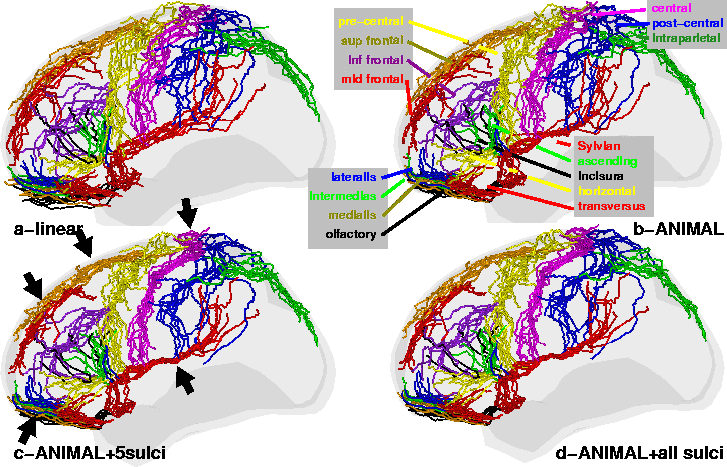
 |
Standard ANIMAL: When applied to real data, the image in
Fig. 3-b shows that that the standard ![]() non-linear
registration is not enough to align cortical structures. In fact, it does
not appear to be much better than the linear registration. This is
confirmed by the quantitative results in Table 2, where the average
non-linear
registration is not enough to align cortical structures. In fact, it does
not appear to be much better than the linear registration. This is
confirmed by the quantitative results in Table 2, where the average
![]() value for the standard
value for the standard ![]() registrations is only slightly better than
that for linear registrations.
registrations is only slightly better than
that for linear registrations.
ANIMAL+selected sulci: The use of 5 paired sulci improves
cortical registration significantly in the neighbourhood of the chosen
sulci as shown in Fig. 3-c. The central sulcus (purple),
superior frontal (orange), middle frontal (red), olfactory (black) and
Sylvian (red) (arrows) are well defined, and this is confirmed by improved
![]() values in Table 2, when compared to the standard
values in Table 2, when compared to the standard ![]() registrations. Unfortunately, the effect appears to be relatively local in
that alignment of neighbouring sulci are only somewhat improved (e.g.,
postcentral sulcus). This is probably because there is no explicit
representation of the other sulci in the registration, so they do not
participate in the fitting process. However, using some labelled sulci
yields a 0.50mm average
registrations. Unfortunately, the effect appears to be relatively local in
that alignment of neighbouring sulci are only somewhat improved (e.g.,
postcentral sulcus). This is probably because there is no explicit
representation of the other sulci in the registration, so they do not
participate in the fitting process. However, using some labelled sulci
yields a 0.50mm average
![]() reduction (from 4.5 to 4.0mm) that is highly
significant (p<0.0001, T=157,
d.o.f.=320, paired T-test).
reduction (from 4.5 to 4.0mm) that is highly
significant (p<0.0001, T=157,
d.o.f.=320, paired T-test).
ANIMAL+selected sulci+all sulci: When the previous result is used as input for a registration using all sulci as features, then some of the other sulci (e.g., postcentral) come into alignment, however others may be attracted to non-homologous sulci, since no explicit labelling of sulci is used in this step.